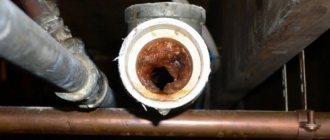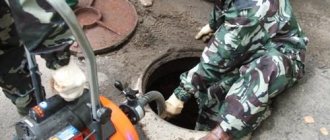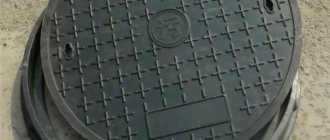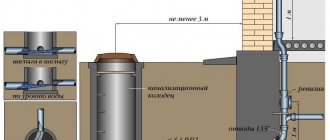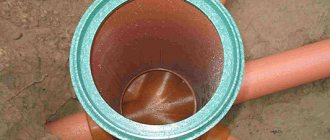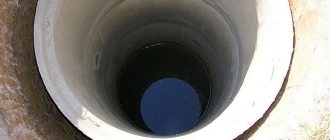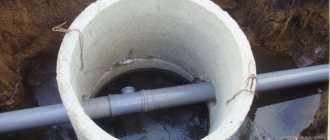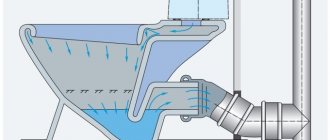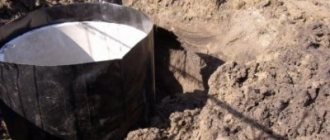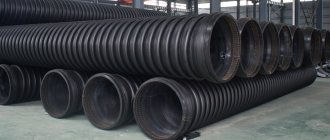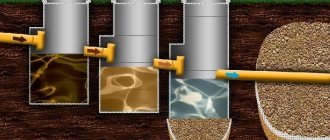The sewer collector of a private house is a pipeline made of pipes (pipeline) through which sewage is discharged and the wastewater collection tank itself is a regular cesspool, septic tank, VOCs, etc. Such a system is also sometimes called a channel. There are three types of collectors:
- domestic;
- shower;
- drainage
Wikipedia says that:
The collector is the main channel of the drainage network.
It is a large diameter pipe. Sewers are part of the city's sewer system; they collect wastewater and transport it outside the sewer system to pumping stations, treatment plants or to a discharge point into a reservoir.
Sometimes small rivers flowing within the city are collected into sewers. Collectors are constructed primarily from large concrete and reinforced concrete blocks.
On the territory of Moscow, about 150 watercourses flow in collectors with a total length of several hundred kilometers. During a rainstorm, a so-called “collector wave” can occur in drainage collectors - a rapid increase in water level.
Source Wikipedia
City sewer collectors, unlike domestic ones, are complex hydraulic structures that run under the entire city. For private housing construction, such systems are more modest in size and length. Let's take a closer look at what a household sewer collector is, its components, etc.
Video: Sewer
storm sewer collector
English-Russian Dictionary of Technical Terms. 2005.
See what a “storm sewer collector” is in other dictionaries:
storm sewer collector — — Energy industry topics in general EN storm sewer ... Technical Translator's Guide
SEWER WATER COLLECTOR - a collector for collecting and discharging wastewater from the storm sewer network (Bulgarian language; Български) drainage sewer collector (Czech language; Čeština) dešťový kanalizační sběrač (German language; Deutsch) Abwassersammelkanal (Hungarian ... ... Construction Dictionary
sewer drainage collector - Collector for collecting and discharging wastewater from the storm sewer network Topics water supply and sewerage in general EN storm sewerstormwater sewer DE... ... Technical Translator's Guide
Kamenka (river, flows into the Sea of Japan) - This term has other meanings, see Kamenka. Kamenka Upper Kamenka Characteristics Length ... Wikipedia
Samorodinka (river) - Samorodinka Valley of the Samorodinka River Characteristics Length 7 km Basin area 11 km² ... Wikipedia
Flon (river) - Flon fr. Flon Upper reaches of the Flon ... Wikipedia
Igumenka (river, Chelyabinsk region) - This term has other meanings, see Igumenka. Igumenka is a small river in the city of Chelyabinsk, 9 km long, a right tributary of the Miass River, almost completely enclosed in a collector. When open, it leaks from... ... Wikipedia
Collector wave - A collector wave is the occurrence of a large flow of water in the collectors of underground rivers and streams during a rainstorm. This is due to the fact that storm sewer systems are usually connected to the collectors of underground reservoirs. Therefore, during... ... Wikipedia
Underground passages of Minsk - The building of the Republican Prosecutor's Office on the site of the former Church of St. Wojciech There are not many historical dungeons in Minsk, mainly in the historical center in the area ... Wikipedia
dic.academic.ru
Construction of a sewer collector
Sewage collector is a system of pipes and pipelines designed to carry sewage and waste to a collection point, which is usually served by a reservoir or, simply, a cesspool. This is the most standard sewer well device, however, there are other, more complex, but also more practical, sealed and non-poisonous soils. Absolutely all types can be equipped with your own hands, all you need is an investment of finances and labor costs.
Methods for arranging a sewer collector
It is worth immediately noting that this is not a heating collector, but another device, which is a pipeline from a system of pipes laid in trenches. Sometimes a sewer structure is called a channel, and this will make it clearer what a sewer collector is and why it is needed.
A regular cesspool is a device that receives all wastewater. At the same time, a pit can be equipped literally in a matter of hours, simply by digging a foundation pit on the site, covering it with brick or something else, as shown in the photo. At the same time, we must not forget that the drain must be cleaned using a vacuum cleaner.
A septic tank is another option for collecting sewage and waste. As shown in the photo, this is a sealed structure that accepts a piping system that transports drains from plumbing fixtures. Such a device requires some preparatory work, but the general principle is the same: a pit is dug into which a reservoir is mounted, drainage pipelines are connected to it, and then the sewerage collector is put into operation.
Installation of a sewer collector
The collector structure is shown at the stage of laying the foundation. The process is simple and does not take much time:
- Below the freezing point of the soil, a trench is dug for the pipeline,
- A sand cushion (up to 20 cm thick) is placed at the bottom of the trench, compacted,
- Pipes are placed on top. For a gravity sewer system, the pipeline is installed with a slope towards the collector reservoir. The maximum slope size is 2 cm per 1 m of pipe,
- The pipeline is insulated,
- The tightness of the joints of the elements is checked by filling the structure with water,
- The trench is dug, the outlet of the pipeline is first lowered into the hole or connected to a septic tank, as shown in the photo.
The system is installed in pressure structures, which are installed in cases where gravity sewerage cannot be installed for one reason or another. Pressure sewerage consists of a tank for collecting wastewater and a pipeline. The line of pipes laid in trenches rises as it approaches the wastewater reservoir, and to prevent the flows from stagnating, the sewer collector is equipped with a pump. Such a system ensures ease of laying sewerage on any terrain and helps to increase the cleanliness of the system as much as possible.
The sewer collector is an important part of the sewerage system, without which it is impossible to construct an autonomous structure. Therefore, the arrangement of the pipeline and reservoir requires care and patience.
Design and principle of operation
A drainage well is a shaft that does not have a bottom.
In most cases, when arranging it, reinforced concrete rings of the calculated diameter are used. Before installation, holes are drilled in the reinforced concrete product, which is installed first, at a height of about 0.5 m from the bottom cut. This increases the productivity of the well in terms of transferring liquid from the drainage system to the ground. The pit is first covered with geotextiles, on which a filter layer is installed: river sand mixed with fine crushed stone or large pebbles. The same building material is used to cover the perimeter of the well shaft.
When choosing the diameter of the rings, the hygroscopicity of the soil is taken into account. The better it absorbs moisture, the smaller the cross-section of reinforced concrete products are taken. But here it is worth considering that a decrease in the filter surface area necessitates more frequent renewal of the backfill. In addition, a lot depends on the volume of daily discharge into the sewer system.
Drainage wells are connected to all versions of septic tanks. But the degree of clarification of wastewater is determined primarily by the VOC model.
Pressure sewerage system made from pipes
The main element of the pressure sewer system is the SPS (sewage pressure station). The sewage pumping station collects all wastewater located in the internal pipelines of the building. The force of a powerful pump transports waste to the place of disposal. The pumping station operates as a storage tank, but only up to a certain level (for more details: “KNS sewage pumping station - principle of operation and types of installation”).
If such a distance cannot be ensured for one reason or another, or if sewer pipes must be laid higher than water pipes, then protective measures must be applied. Such measures may include laying a water pipeline from steel pipes or a sewerage system from cast iron, laying a water pipe in a protective case with a length of at least 5 m in each direction from the intersection in clay soils and 10 m in filtering ones.
If the sewer collector crosses the walls of tunnels, chambers, basements, etc., it must be enclosed in a case, the ends of which extend 0.2 m from the outer plane of such walls. The vertical distance between the sewer pipe and other communications intersected in the tunnel is at least 0.15 m.[.
The reasons may be different:
• if there is no free-flow sewer nearby for tapping, pressure sewers pass nearby, and water discharge into free-flow networks is impossible; • if the organization of a natural slope is impossible due to the large distance to the free-flow collector; • if the water intake point is located at a great depth; • if laying a gravity sewer is expensive or troublesome.
How to install polypropylene pipes?
Which radiators are preferable to use in an apartment or house?
www.684015.ru
Construction and operation
Correctly installing inspection systems for a dacha or private home is one thing; maintaining them in working order for a long time is quite another. If maintenance is not carried out after some time, the entire drainage system will not be effective. To avoid this, it is recommended to carry out preventive work:
- Check the connection between the drain and the ditch and the drainage drains. A lot of garbage can accumulate here. Contaminants can be very different: silt, leaves, soil particles, etc. Therefore, shafts must be provided with ladders for the necessary cleaning.
- Particular attention is paid in winter. The groundwater level becomes lower during this period. Therefore, there will be no water in the pipes and collector. In this case, the system should not be preserved for the winter, since the pipes were initially placed at a depth below the soil freezing level. Moreover, the presence of crushed stone and sand creates a layer resistant to deformation.
- If washing is necessary, it is carried out with water pressure.
- Once every 15 years, a global cleaning and flushing of the entire drainage system is performed.
- The serviceability of the pumping equipment is checked.
- It is necessary to make sure that the hatches reliably cover the container from the entry of debris from the outside.
Sewer collector
Great Soviet Encyclopedia. - M.: Soviet Encyclopedia. 1969—1978.
See what a “sewer collector” is in other dictionaries:
sewer collector - sewer collector Pipeline of an external sewer network for collecting and discharging wastewater. sewer collector A section of an external sewerage network for collecting and discharging wastewater from one or more swimming pools... ... Technical Translator's Guide
Sewer collector - a pipeline of an external sewer network for collecting and discharging wastewater. Sewer collector A section of an external sewer network for collecting and discharging wastewater from one or more sewer basins.... ... Encyclopedia of terms, definitions and explanations of building materials
Collector (sewer) - Collector of the Neglinka River in Moscow. This term has other meanings, see Collector. Collector is the main channel of the drainage network. Imagine... Wikipedia
sewer collector - 3.9 sewer collector: Pipeline of an external sewer network for collecting and discharging wastewater. Source... Dictionary-reference book of terms of normative and technical documentation
SEWER COLLECTOR - a section of an external sewer network for collecting and discharging wastewater from one or more sewerage basins (Bulgarian language; Български) sewer collector (Czech language; Čeština) kanalizační sběrač (German language; Deutsch) Sammler... ... Construction Dictionary
basin sewer collector - A collector designed for collecting and discharging wastewater from the sewer network of one sewer basin Topics water supply and sewerage in general EN... ... Technical Translator's Reference
sewer drainage collector - Collector for collecting and discharging wastewater from the storm sewer network Topics water supply and sewerage in general EN storm sewerstormwater sewer DE... ... Technical Translator's Guide
main sewer collector - A collector that collects wastewater from two or more basin sewer collectors Topics water supply and sewerage in general EN main sewer DE... ... Technical Translator's Guide
suburban sewer collector - A collector that discharges wastewater in transit outside the city to pumping stations, wastewater treatment plants or to the point of discharge into reservoirs. Topics: water supply and... ... Technical Translator's Guide
sewer unloading collector - A collector installed in the system of an existing sewer network to unload existing sewer collectors that do not have the required throughput. Topics... Technical Translator's Directory
dic.academic.ru
Sewer collector - all about the main element in the sewerage system
Today it is difficult to imagine the appearance of modern cities if all wastewater were not disposed of by the sewer system. Without its development, installing a toilet inside a residential building would have been impossible. As a result, the installation of a sewer system is one of the most important tasks during the construction of a multi-storey, private house or country cottage. The entire system is connected by a sewer collector.
Problems of drainage care in cities
Every home, business, and public institution needs drinking and industrial water, which forms wastewater. The internal sewer system is connected to the street sewer, except in cases where the wastewater is treated by individual treatment plants.
A slope is always provided for drainage of wastewater, so it is not difficult to connect the building’s sanitary equipment to the public sewerage network. But in cities it often happens that the room is located below the level at which the sewer is located, and there is no free flow. If it is not actively filled, then it is not possible to remove wastewater from such premises. However, if the collector is subject to heavy filling, backwater occurs, which leads to flooding by backflow of water.
To solve this problem, a non-return valve is used, which protects the room from flooding. Also, in low-lying areas of the city, a pressure sewer is used, which can more efficiently receive wastewater. Individual pumps can be installed to improve the removal of wastewater from low areas of the city.
Note! For these purposes, it is recommended to use pumps that operate autonomously.
Pump - help for drowning people
The problem of sewerage connections is acute for residents of private houses. Let's figure out how to do this and connect to the collector output. This is the main task if the house does not have individual treatment facilities. For houses located on a hill, everything is very simple: a sewerage connection is made with access to the street communications network, and waste flows into them by gravity. It is more difficult if the house is below the level of the collector. Then it is necessary to make a pressure sewer with a pump.
For such sewerage, two types of pipes are used:
- Polyvinyl chloride (PVC),
- Polyethylene (PE).
Pipes with a diameter of up to 90 millimeters are supplied in coils, which reduces installation time. The pumping station can be located both inside the house and outside. The pump can operate for a long time without overheating, thanks to its reliable design, which gives the device greater strength.
Note! In a reliable pump, all parts are made of high-strength steel, only this can serve as a guarantee of its quality.
Principle of operation
In order for all the waste to get into the collector, a properly executed sewerage connection is necessary, only this guarantees reliable drainage of wastewater. The correct system functions as follows: all waste is moved into a special sealed container, then it is crushed by a pump and pumped into treatment facilities and a collector.
Important! Designing a pressure sewer is a complex undertaking, so it is better to contact a specialist. The diameter of the pipes for such a system is 32 millimeters, and their thickness is calculated so that the flow speed is no more than 0.7 meters per second
When this speed is reached, the self-cleaning system of sewer pipes comes into play.
The diameter of the pipes for such a system is 32 millimeters, and their thickness is calculated so that the flow speed is no more than 0.7 meters per second. When this speed is reached, the self-cleaning system of sewer pipes comes into play.
Advantages of pressure sewerage:
- The volume of excavation work performed is less,
- By using less material over longer distances, the cost is lower,
- Installation time is reduced,
- The service life of such a system is designed for 50 years.
Types of wells and installation locations
The main task of wells is to monitor the general condition of systems.
Not so long ago, only concrete was used to create wells.
Reinforced concrete products such as rings, covers with holes for manholes, and bottoms, which are currently produced in large quantities, are used in the installation of high-capacity storm sewers.
In private houses, they made cesspools with their own hands, digging holes to a certain depth. After this, the walls were covered with bricks and waterproofed.
Today, concrete wells have faded into the background, giving all the laurels to plastic or fiberglass products. In addition, the developers of these wells have made a huge range of sizes, and this is very popular with designers when creating modern wells.
A well is a closed cylindrical vertical working chamber with embedded inlet and outlet pipes for the purpose of connecting to a storm sewer pipe system.
The well also has an inspection window or a service hatch, which allows you to go down to check the sewage system.
Another advantage of plastic wells is their ability to be assembled and disassembled.
Inspection wells in accordance with SNiP 2.04.03-85 are required to be installed:
- At the confluence of two or more water streams.
- At points where the direction of the sewer system changes.
- In places where the slope of the pipes varies.
- At points where a transition is made from pipes of the same diameter to other pipes of different diameters.
- On straight sections - at certain distances, depending on the diameter of the sewer pipe, for example:
- DN up to 150 mm – 35 m;
- DN 500-600 mm – 75 m, etc.
- DN 200-450 mm – 50 m
The dimensions of the pipes used will determine the diameter and height of the well.
In order to reduce hydraulic resistance in rotary wells, inserts are often used - these are gutters with a guiding function that ensure trouble-free passage of water flow in the required direction.
Wells are a very important element in the treatment of storm water collection.
Cleaning the cavity of a well is much easier than cleaning storm drains or flushing clogged or silted pipes.
For special differential wells, it is necessary to change the depth of the sewer pipes.
In this situation, the location of the outlet pipe of the required diameter should be higher than the inlet.
This may be relevant if it is necessary to reduce the depth of laid sewer pipes or to bypass underground obstacles. The installation of a storm drainage system at an industrial facility involves exceptional purification of the water flow before it is taken into a reservoir or onto a field with filtration.
In this case, specialized wells are equipped to take samples for the content of chemical components or suspended petroleum products in the water. They are installed after local stormwater treatment facilities in front of the output storage tank-collector.
From what and how to make it correctly?
Basically, two materials are used to organize this engineering system:
A cushion is placed under the drainage drain made of concrete rings, acting as a filtration. It has a thickness of up to 500 mm and consists of:
- from sand;
- medium gravel;
- crushed stone
Installation of concrete rings is carried out strictly in a vertical position. The collector is equipped with a hatch on top.
Plastic wells. Such products are distinguished by their low weight, simple design and high strength. In appearance, it is a corrugated pipe, a tray with pipes, a neck, a plastic cover and an extension, this concerns the prefabricated structure. There is also a monolithic one. It is much stronger in compression.
Storage collectors for storm sewers
No matter how extensive the storm sewer project is, as a rule, it is “tied” to a single specific spillway point.
Thus, water flows are collected in one single channel or reduced to one reservoir. This deep technical plumbing equipment is called a manifold.
The collector can be a pipe made of reinforced concrete or polymer material, which is located horizontally. Pipelines from all water collection areas must cut into it.
If the collected water requires additional purification, then special filters of various types of purification should be placed on the collector.
After this, the water is diverted to drainage fields or discharged into reservoirs.
It is often more profitable to divert water into closed collectors than to discharge it. Closed-type collectors are sealed products with one chamber and the ability to purify water.
If you use a closed cycle on a storm sewer system, you can achieve significant water savings. This technique is used in industrial enterprises (such as, for example, car washes).
In a private home, such a technique can bring many benefits. As a rule, storm water in these situations is not contaminated and after stages of purification in sand traps for storm sewers, as well as after settling in closed-type collectors, this water can be used for domestic or agricultural purposes. In order to economically use storm water for these purposes, it is enough to install a submersible pump.
Often, instead of a collector, the above large wells are used. They can still collect rainwater and divert it to discharge points.
v-dom-voda.ru
What is it, how does the device work?
A drainage well is a special shaft in the ground made of reinforced concrete or PVC. It consists of a bottom, a working area, a hatch and allows you to collect excess water from the area. All moisture enters the shaft through the pipe, and it allows the entire system to be cleaned.
Drainage is especially necessary when the house is located in a lowland, and the area has a relatively high level of precipitation or there is groundwater very close by.
Installation of a drainage well:
- eliminates flooding of the cellar and basement;
- reduces groundwater pressure;
- drains the soil on the site.
The inspection shaft diagram consists of the following elements:
- Luke. It prevents excess debris from entering the pit and also allows for servicing the collector;
- neck – load-bearing part of the structure;
- shaft - vertical tunnel;
- bottom - used to collect sediment.
Inspection systems for drainage are required:
- for periodic washing of the structure;
- monitoring the performance of pipes;
- carrying out scheduled maintenance.
In the absence of this communication, water will accumulate in the local area. Even if you lay a drain and do not install an inspection well, the entire system will become clogged and moisture will remain in the soil.
